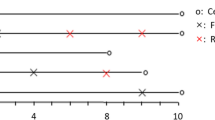Abstract
We attempt to examine the extent to which poverty in childhood adversely affects success in adulthood, using micro data from nationwide surveys in Japan and taking into account the recursive structure of life outcomes. We use retrospective assessments of income class at the age of 15, because longitudinal data on household income are not available. After controlling for its endogeneity, we confirm that children from poor families tend to have lower educational attainment, face higher poverty risks, and assess themselves as being less happy and as suffering from poorer health.





Similar content being viewed by others
Notes
Wilde (2000) argues that one varying exogenous regressor in each equation is sufficient to avoid identification problems in multi-equation probit models with endogenous dummy regressors. As mentioned by Wilde, this argument depends on the assumption of a multivariate normal distribution of the disturbances.
The 2004 Survey was not conducted.
The number of siblings was not collected in the 2003 JGSS. We repeated the estimations by including it in “poor at age 15” and “graduated from college or above” equations and using data from the 2000–2002 and 2005–2006 surveys. We confirmed its significant impact (positive for “poor at age 15,” and negative for graduated from college or above) but no substantial difference in the other estimated parameters.
References
Abe, A. (2008). Kodomo no hinkon [Child poverty]. Tokyo: Iwanami Shoten. (Japanese).
Ben-Shlomo, Y., & Kuh, D. (2002). A life course approach to chronic disease epidemiology: Conceptual models, empirical challenges and interdisciplinary perspectives. International Journal of Epidemiology, 31, 285–293.
Blanchflower, D. G., & Oswald, A. J. (2004). Well-being over time in Britain and the USA. Journal of Public Economics, 88, 1359–1386.
Blau, D. M. (1999). The effect of income on child development. The Review of Economics and Statistics, 81, 261–276.
Bowles, S., Gintis, H., & Groves, M. O. (2005). Unequal chances: Family background and economic success. Princeton: Princeton University Press.
Cappellari, L., & Jenkins, S. P. (2003). Multivariate probit regression using simulated maximum likelihood. The Stata Journal, 3, 278–294.
Carneiro, P., & Heckman, J. J. (2003). Human capital policy. In J. Heckman & A. Krueger (Eds.), Inequality in America: What role for human capital policies (pp. 77–239). Cambridge, MA: MIT Press.
Clark, A. E., & Oswald, A. J. (1994). Unhappiness and unemployment. Economic Journal, 104, 648–659.
Corcoran, M. (1995). Rags to rags: Poverty and mobility in the U.S. Annual Review of Sociology, 21, 237–267.
Di Tella, R., MacCulloch, R. J., & Oswald, A. J. (2001). Preferences over inflation and unemployment: Evidence from surveys of happiness. American Economic Review, 91, 335–341.
Duncan, G. J., & Brooks-Gunn, J. (Eds.). (1997). Consequences of growing up poor. New York: Russell Sage.
Duncan, G. J., Yeung, J. W., Brooks-Gunn, J., & Smith, J. R. (1998). How does childhood poverty affect the life chances of children? American Sociological Review, 63, 406–423.
Easterlin, R. A. (2001). Income and happiness: Towards a unified theory. Economic Journal, 111, 465–484.
Frey, B. S., & Stutter, A. (2002). What can economists learn from happiness research? Journal of Economic Literature, 40, 402–435.
Haveman, R., & Wolfe, B. (1995). The determinants of children’s attainments: A review of methods. Journal of Economic Literature, 33, 1829–1878.
Kuh, D., Ben-Shlomo, Y., Lynch, J., Hallqvist, J., & Power, C. (2003). Life course epidemiology. Journal of Epidemiology and Community Health, 57, 778–783.
Lleras-Muney, A. (2005). The relationship between education and adult mortality in the United States. Review of Economic Studies, 72, 189–221.
Maddala, G. S. (1983). Limited-dependent and qualitative variables in econometrics. Cambridge: Cambridge University Press.
Mayer, S. (1997). What money can’t buy: Family income and children’s life chances. Cambridge: Harvard University Press.
OECD. (2006). Economic survey of Japan 2006. Paris: OECD.
OECD. (2008). Growing unequal? Income distribution and poverty in OECD countries. Paris: OECD.
Oishi, A. (2007). Kodomo no hinkon no doko to sono kiketsu [Child poverty: Its trends and consequences]. The Quarterly of Social Security Research, 43, 54–64. (Japanese).
Seccombe, K. (2000). Families in poverty in the 1990s: Trends, causes, consequences, and lessons learned. Journal of Marriage and Family, 62, 1094–1113.
Seccombe, K., & Ferguson, Susan. J. (2006). Families in poverty: Volume I in the “Families in the 21st century series”. Boston: Allyn & Bacon.
Shea, J. (2000). Does parents’ money matter? Journal of Public Economics, 77, 155–184.
Smith, J. P. (1999). Healthy bodies and thick wallets: The dual relation between health and economics status. Journal of Economic Perspectives, 13, 145–166.
Tachibanaki, T. (2005). Confronting income inequality in Japan. Cambridge, MA: MIT Press.
Wilde, J. (2000). Identification of multiple equation probit models with endogenous dummy regressors. Economics Letters, 69, 309–312.
Winkelmann, L., & Winkelmann, R. (1998). Why are the unemployed so unhappy?: Evidence from panel data. Economica, 65, 1–15.
Acknowledgments
The data for this secondary analysis, the Japanese General Social Surveys (JGSS), was provided by the Social Science Japan Data Archive, Information Center for Social Science Research on Japan, Institute of Social Science, the University of Tokyo. The JGSS are designed and carried out by the JGSS Research Center at Osaka University of Commerce (Joint Usage/Research Center for Japanese General Social Surveys accredited by Minister of Education, Culture, Sports, Science and Technology), in collaboration with the Institute of Social Science at the University of Tokyo. We appreciate the financial support provided by Grant-in-Aid for Scientific Research on Priority Areas (21119004) and Grant-in-Aid for Scientific Research (B) (21330057).
Author information
Authors and Affiliations
Corresponding author
Rights and permissions
About this article
Cite this article
Oshio, T., Sano, S. & Kobayashi, M. Child Poverty as a Determinant of Life Outcomes: Evidence from Nationwide Surveys in Japan. Soc Indic Res 99, 81–99 (2010). https://doi.org/10.1007/s11205-009-9567-x
Accepted:
Published:
Issue Date:
DOI: https://doi.org/10.1007/s11205-009-9567-x




